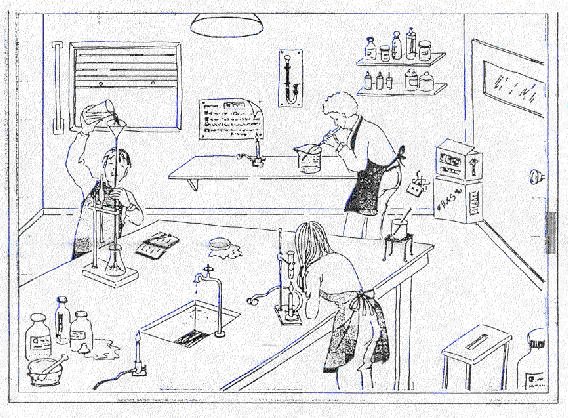1. Activitat per introduir conceptes com: suspensions solucions
i emulsions. Teoria, desenvolupament pràctic, reforç
de conceptes i vocabulary
4. SUSPENSIONS,
SOLUTIONS AND EMULSIONS
A suspension is cloudy
A mixture of little particles in a liquid media like water looks
like a cloudy liquid because particles stay floating in the water.
They may stay there for several hours, but most of them will eventually
fall to the bottom of the beaker.
A solution is clear
If you add a soluble material to water it seems to disappear, because
the particles formed are so little that you cannot see them.
Substances can be soluble o insoluble, depending on the solvent
used:
– Water dissolves ionic and polar substances.
– Organic solvents dissolve apolar substances.
Immiscible liquids can
form emulsions
When you mix to liquids there is two possibilities:
– They mix, perfectly dissolve, like water and ethanol
or
– They stay in two layers, like water and oil.
The firth ones is called
miscible liquids and the second ones are called immiscible liquids.
• Chemical principle: miscible liquids
are equivalent, either polar or apolar. Two liquid are immiscible
when one is polar and the other apolar.
• If you stir and shake vigorously two immiscible liquids,
they break in tiny droplets and looks like it’s homogenous.
You got an emulsion.

WH -QUESTIONS:
a) What is a suspension?
b) What is a solution?
c) When two substances
dissolve?
EXPERIMENT: OBSERVE AND SEPARATE SUSPENSIONS
Read first and follow
the instructions:
1. - Use a beaker and put in 50 cm3 of water.
2. - Add flour and stir.
3. - Write down what you observe.
4. - Try to separate the components of this suspension using different
methods. Write down what you observe.
| –
4a) Prepare a filter and filtrate the suspension using a funnel
and an Erlenmeyer. The clear part is called filtrate and the
solid part you find in the funnel is the residue. Describe the
process. |
|
– 4b) Filtrate a suspension can be very slow. It could
help to use a water vacuum pump. Do it by following the teacher
instructions. . Describe the process |
|
– 4c) Use a centrifuge.
Put exactly the same amount of suspension in each of the two centrifuge
tubes that the teacher gives you.
Set them in the centrifuge and star the centrifugation process.
Stop them and decant the liquid on top. . Describe the process.
2. Activitat sobre seguretat
al laboratori
6. LABORATORY
SECURITY RULES
1.- Wear a comfortable
and resistant laboratory coat and laboratory glasses.
2.- Don’t touch the chemicals with your hands
3.- Don’t taste any chemicals
4.- Don’t smell any products without the teacher’s permission
5.- Don’t eat or dink in the laboratory
6.- Be careful with inflammable products
7.- Be careful with electricity and gas
8.- Tell your teacher immediately if you have an accident
9.- Clean the products you spill with water immediately
10.- Wash your hands before you leave the laboratory
To perform an experiment, remember:
a) Read the instructions about the experiment carefully.
b) Follow the instructions and don’t make any changes
c) Ask your teacher about any doubts you have
d) Check the material before you begin the experiment
e) Use clean tools to do the experiment
f) Clean all your tools after the experiment
g) Write down every observation in your laboratory notebook
h) Throw the remains of the materials used away in special containers.
Exercise:
Observe this image.

Look at the picture.
What rules do these people follow?
What rules do they break?.
Write the rules in the
corresponding column.

Finally discuss and decide
which two the rules could be considered basic.
3. Contextualització
dins de l’estudi dels polímers
4. FRONTIERS
IN THE WORD OF CHEMISTRY
Elephants,
Piano Keys, and Polymers
Until recently, no synthetic material has matched ivory. It was
not easy to find a material with a good response to the delicate
touch of a concert pianist. Piano keys covered with plastic have
been rejected. They were too slippery and too cool. Eventually,
however, a replacement for ivory must be found in an effort to halt
the destruction of elephants.
A team of scientists has patented a new material that may solve
the problem. The essential step in their work was analysis of the
surface of natural ivory at the microscopic level by specialists
in friction of materials. An ivory surface, they found, is covered
with ridges, valleys and tiny pores. When a sweaty finger slides
over such a surface, it alternately sticks and slips, creating the
feeling the pianists need for better control. The pores make an
important contribution by absorbing sweat and oil from the finger.
Ultimately, they developed a synthetic ivory made from a mixture
of liquid polyester, a white titanium pigment, and finely powdered
poly(ethylene glycol), a water-soluble polymer. When the material
is soaked in hot water after it has hardened, the poly(ethylene
glycol) is dissolved away, leaving behind pores like those in natural
ivory. This new material has met the ultimate test. Concert pianists
have failed to detect a difference between Steinway pianos with
keys covered by the new material, known as RPIvory, and those with
keys of natural ivory.
Questions:
1.- Why piano keys covered with plastic had been rejected by concert
pianists?
2.- Why a replacement
for ivory must be eventually found?
3.- Which was the essential
step in the way to find an ivory substitute?
4.- How is the ivory
surface?
5.- Which is the contribution
of the ivory surface pores to the good feeling during a piano concert?
6.- Which are the compounds
in this new material, known as RPIvory?
4.
Introducció d’un tema: Malalties bacterianes
INTRODUCTION
- Name some of the major
fatal diseases
- How do antibiotics
work?
- What causes AIDS?
- Which are some important
pain-killing and mood-altering drugs?
- In which conditions
can medicaments against cold be use?
READ AND ANSWER
Everyone is interested
in developments that influence public heath and most particularly,
their own personal heath. Knowledge, however, is our personal first
line defence.
What roles does chemistry play in this increase in life expectancy
and other improvements in the quality of live? Bacterial diseases
have been conquered by antibiotics. Vaccines have vastly decreased
the risk from epidemic diseases such as polio. And an array of synthetic
materials for replacing arteries hip joints, and other body parts
has been developed through laboratory research.
Most importantly, remarkable progress has been made in recent years
in understanding the chemical reactions that regulate body processes.
Drug molecules are being designed to have exactly the molecular
shape and chemical reactivity needed to counteract disease.
- What is our first
option to beat (overcome) diseases?
- What has helped us
to overcome bacterial diseases?
- Laboratory research
has produced thousands on chemical substances that act as medicines
and other compounds to ........................................................................................................................
- Write the name of
ten medicines that you can find in you house and ten that you
can buy from the drugstore.
- Choose ten legal drugs
and write their trade name to the left. In the right column write
the generic name.
- What do we need to
make a remarkable progress in synthesis new medicines?
- Drug molecules are
being designed to have .........................................................................
|






